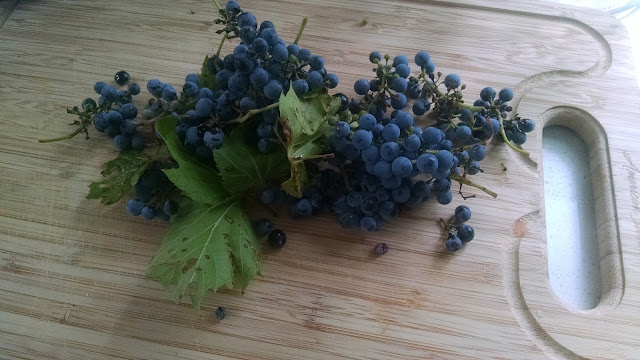Wild Grapes...Homemade Wild Wine?
Baruch atah, Adonai
Eloheinu, Melech Haolam,
borei p'ri hagafen
(Rabbinic Jewish Blessing for the Sabbath Wine)
 |
| Here, a stand of it is growing on a tree. |
My best foraging discoveries are often providence. I like to pray for God to surprise me when I'm out foraging, hunting, or fishing. If you spend long enough in the woods, you begin to discover things you may have walked by a hundred times, even in the trail head parking lot. Well, earlier this year, I did some research on the varieties of wild grapes that grow in Missouri. I didn't really know where to look for them. The providence piece comes in here.
I pulled up to a parking lot I've often frequented on mushroom hunts and I noticed clusters of blueish berries hanging from a series of vines. Before, I would've ignored them, assumed they were poisonous, but I had a feeling about them. I gathered a good amount, took a few leaves with me to help with identification and went home.
Well, let me introduce, the Riverbank Grape, an edible wild grape native to Missouri.
Wine is a big business in Missouri. European settlers in the 1800s brought their wine culture to the sandy hills of the Missouri River region and wine towns, such as Hermann, still thrive off the production. It's worth a drive to wind in and out amongst the wineries and orchards of central Missouri.
There are eight wild varieties of grape in Missouri, some of which have been naturalized (varieties brought from other places that have reached balance in the ecosystem). They all belong to the group Vitis.
The Riverbank Grape is the Vitis Riparia (think Riparian sections of a river).
BE YE WARNED...there is a potentially deadly look-alike, Moonseed. Sometimes, they grow right next to each other, so it's very important to know the difference. Ye gods! Don't worry, here are the identifying characteristics so that you don't make the mistake of eating moonseed.
Riverbank Grape (EDIBLE)
Deep blue/purplish fruits, often with a white, waxy coating
rough bark that looks like it is peeling at points
*leaves have teeth!
tendrils connecting vine to host
*1-4 pear shaped seeds (open more than one grape to see)
 |
| These are what the leaves look like. Notice they have three main points, but have "teeth" all around the edges. |
 |
| The bark looks like it's peeling. |
Moonseed (POISONOUS)
*Leaves don't have teeth
*1 flat, white, crescent shaped seed
no tendrils
 |
| credit: backyardnature.net |
Notes on Identification
When identifying a plant, you can't trust just one feature. Plants live in certain contexts and are identified by more than one characteristic. There are also possible variations in leaf pattern that could throw you off. Make absolutely sure, 100% that you know what you're eating before you put it in your mouth! I am not in any way responsible if you eat something you shouldn't.
Eating Wild Grapes
I suppose in certain situations, you could eat them plain, but they are pretty tart and small. Plus, if you ate too many seeds, well, things might come to a halt (let the reader understand). I haven't gotten to experiment, but you could possible make a jelly. Of course, their main historical use has been wine. SO, I'm currently doing research on making wine at home as well as seeing if I can get a cutting from the plant to grow! This could be the start of something very, very fun.





Comments
Post a Comment